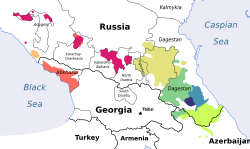This article should specify the language of its non-English content using {{ lang }} or {{ langx }}, {{ transliteration }} for transliterated languages, and {{ IPA }} for phonetic transcriptions, with an appropriate ISO 639 code. Wikipedia's multilingual support templates may also be used - notably tab for Tabassaran.(January 2025) |
| Tabasaran | |
|---|---|
| Tabassaran | |
| табасаран чIалtabasaran ç̇al ихь чIалix ç̇al | |
| Pronunciation | [tɑbɑsɑrɑnt͡ʃʼɑl] [ixt͡ʃʼɑl] |
| Native to | North Caucasus |
| Region | Southern Dagestan |
| Ethnicity | Tabasarans |
Native speakers | 126,900 (2010 census) [1] |
| Official status | |
Official language in | Russia |
| Language codes | |
| ISO 639-3 | tab |
| Glottolog | taba1259 |
| ELP | Tabasaran |
 Map of Tabasarans in the Caucasus | |
 Tabasaran is classified as Vulnerable by the UNESCO Atlas of the World's Languages in Danger . | |
Tabasaran (also written Tabassaran) is a Northeast Caucasian language of the Lezgic branch. It is spoken by the Tabasaran people in the southern part of the Russian Republic of Dagestan. There are two main dialects: North (Khanag) and South Tabasaran. It has a literary language based on the Southern dialect, one of the official languages of Dagestan.
Contents
- Geographical distribution
- Phonology
- Consonants
- Vowels
- Writing system
- Cyrillic (19th century)
- Latin (1931–1938)
- Cyrillic (1938–present)
- Grammar
- Cases
- Samples
- References
- External links
Tabasaran is an ergative language. The verb system is relatively simple; verbs agree with the subject in number, person and (in North Tabasaran) class. North Tabasaran has two noun classes (that is, grammatical gender), whereas Southern Tabasaran lacks noun classes / gender.


